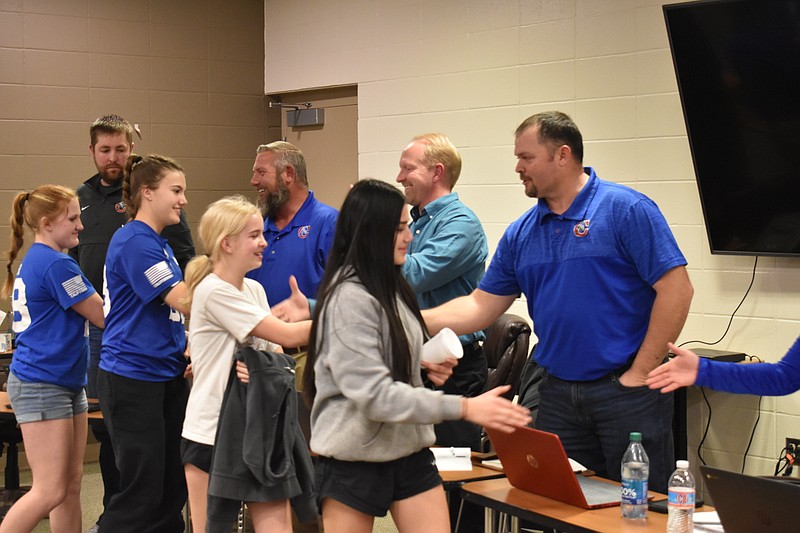A highly sought-after girls soccer program is coming to California.
The California R-I Board of Education was met with excitement March 15 as it approved the new school-sponsored program in a packed room at the California High School media center. Other highlights from the meeting included a program spotlight for counseling, a presentation of an agricultural issues forum skit and a sneak peek at a proposed redesign for California High School's gymnasium floor.
Girls soccer
Proponents of a school-sponsored girls soccer program returned two months after initially vocalizing the need for such a program at the January school board meeting. In that meeting, supporters were met with disappointment as the board countered with concerns over funding and its impact on other athletic programs like track and field.
An outline of initial startup costs published on BoardDocs, a portal for board meeting documents, in January indicated the new program would cost $35,000-$38,000 to get off the ground. The costs include coaching stipends, uniforms, supplies and work to be done to rehabilitate Old Riley Field to utilize for practice. Recurring expenses, including the coaching stipend, equipment and field maintenance, would be approximately $14,000 annually. Superintendent Daniel Williams said after the January meeting he was primarily concerned with the potential for the district to be deficit spending, and felt it would be better to wait before adding any new programs. He also was concerned about creating a program that might only exist for one or two seasons due to a lack of funding.
Following the January meeting, proponents of a girls soccer program went door-to-door and asked for pledges from community members. Zach Hackett, a proponent, said their group raised more than $25,000 in pledges from the community, most recently with a $3,000 check from the California Fraternal Order of Eagles. The City of California also started working to rehabilitate Old Riley Field for use by the school or recreation leagues, further reducing costs to get the program going.
In addition to pledges received, Hackett also provided additional details at the meeting -- including a list of other schools the new program could play and more definitive numbers for costs to run the program.
"I've ran some numbers, just to figure out how much this would cost us, and at no point -- even if we travel to Clinton, which is a long way from here -- that cost would be $357.32," he said. "That's paying the driver six hours. Some of these games will be a lot closer than that, so you wouldn't necessarily have to pay that driver six hours. ... So at no point, in any of our travels, do we really approach the $400 mark that was kinda mentioned in Mr. Williams' bit."
Williams later said Durham School Services, transportation provider for the district, typically bills fuel separately, which he said was likely omitted from Hackett's calculations. Williams said transportation costs would still likely remain around or below $400 per game.
Hackett said traveling for the first season would likely save some costs, as they could still compete without needing to pay officials, purchase equipment for Old Riley Field (such as a scoreboard or bleachers) or rehabilitate Old Riley Field into a competition-ready field. In case California is required to host district tournaments, the district would need to locate a suitable neutral site, likely at a neighboring district with an adequate facility.
Discussion then turned to the field itself. Leslie Scheidt, parks and recreation supervisor for the City of California, marked and measured Old Riley Field to be 55-yards wide by 110-yards long. The National Federation of State High School Associations (NFHS) recommends fields be 55- to 80-yards wide by 100- to 120-yards long. Later, Williams said Missouri State High School Activities Association (MSHSAA) requires soccer fields to be 70-yards wide by 120-yards long. According to Appendix C of the MSHSAA soccer manual (page 19), the field must be at least 60-yards by 110-yards for state tournament games, but the 70-yard by 120-yard dimensions is "strongly recommended ... when possible." Hackett said two other area schools, Smithton and Iberia, already use undersized fields. (Smithton's field is the same size as Old Riley Field, while Iberia's field is shorter at 55-yards by 80-yards.)
Sean Hutchinson, soccer coach at Smithton, said he has "never seen an official measure a field and call the game because it was too small, even if it seemed like it may have been smaller than regulation size." He added Smithton held two Quarterfinal games, and in neither case did an official measure the field.
Other problems exist at Old Riley Field, such as a poorly-placed light pole that would need to be moved and the lack of bleachers or a scoreboard. Hackett said most other schools with grass soccer fields don't have bleachers, and a portable scoreboard could be purchased for $500-650. Old Riley Field already has a concession stand and restrooms.
"I really think Old Riley Field can be used, and should be used," Hackett said. "... I think it's under-utilized and it used to be the centerpiece to this community and now it doesn't get a whole lot of attention. I think these girls would love to share the spotlight with the old historic field if possible."
To further reduce costs, Hackett also said the Otterville R-VI School District has unused soccer equipment it's looking to sell. He also said Chris Miller, president of the Missouri High School Soccer Coaches Association, attended several parent meetings and indicated he'd be willing to help with the search for a coach.
As demonstrated by the full house at the January and March meetings, Hackett said there's sufficient interest between middle and high school students to justify adding the program. Interest in recreational league soccer programs also grown, from 94 participants in 2019 to more than 240 this year. He said the recreation leagues, which have participants ranging from pre-kindergarten through the ninth grade, play several teams from the Lake of the Ozarks region.
Armed with a wealth of additional information about a new girls soccer program, the board members voted to approve it with three conditions: The girls soccer program must be completely self-sufficient for a minimum of three years, the program starts as a travel program for at least two seasons and a head coach is identified to head the program.
The newly-established Lady Pintos girls soccer program is slated to debut in spring 2024.
Program spotlight
Following the approval of an additional athletics program to keep students occupied, the board heard a program spotlight from the group of people who work to maintain students' mental and emotional health, along with their academic and career development.
Four of the five district counselors were present to give an overview of district counseling services, which closely followed a packet uploaded to BoardDocs.
At the elementary school, a Character Strong program was implemented to teach nine character traits -- respect, responsibility, gratitude, empathy, perseverance, honesty, cooperation, courage and creativity. California Elementary School students also participated in spirit weeks for Red Ribbon Week and Bully Prevention Month in October. Elementary school counselors hold one-on-one and group counseling sessions to "work on the social/emotional needs of our students." The elementary school also participates in the Sneaker Project, which donates shoes to students receiving free or reduced lunch. Haley Goans, an elementary school counselor, said the Sneaker Project has provided 19 pairs of shoes to students this year.
Middle school counselors try to do monthly events for students, starting with a suicide prevention presentation in September by the Missouri National Guard's Risk, Reduction, Resistance Suicide Prevention unit. Students also learn about staying drug free in October with Red Ribbon Week, learn about sexual abuse in November from Child Safe of Central Missouri, give with the Giving Tree in December, and learn about drug- and alcohol-prevention, suicide prevention, decision-making and peer pressure from the Council for Drug Free Youth in February. Middle school counselors also work with eighth-grade students on planning their futures by completing their Individual Career and Academic Plan in February.
High school counselors continue assisting students with planning their futures by teaching students about opportunities at the Nichols Career Center in Jefferson City, along with career days and job shadow events. Counselors also help students with completing tests, as well as applying for colleges and scholarships.
Williams commended the district's counselors, saying it is "awe-inspiring" to see them in action.
"They don't get out in front of all of us very often, but we've had a trying year district-wide," he said. "We faced some significant tragedies as a district, and watching this group of ladies plus Miss (Rebecca) Maher (high school counselor who was absent from the meeting) support our students and support our staff through some of that was something that, it was pretty awe-inspiring to watch that happen. We're facing mental health issues on a daily basis that are unlike anything most of us have ever seen in our educational careers. ... They don't get enough credit for that in a public setting."
New business
Five agriculture students opened the new business portion by presenting a skit on veterinary feed directive, a government regulation that requires over-the-counter antibiotics for livestock to be prescribed by a veterinarian.
Alexandra Gast, a student teacher of agriculture at California High School, said the skit is an example of agricultural issues forums that agriculture students participate in.
"It's basically an extension of the curriculum that we work on in class, and so these five have selected a current ag issue that is prevalent in affecting consumers, producers and regular folks involved in the industry, and they developed a skit that basically explains the issue," she said. "But we are tasked with completing five high-quality ag issue forums, basically where they present to community members, stakeholders, people that have a special interest in the topic, to kind of communicate (the issue) to the public then they go to contests and present."
Following the presentation, a visitor spoke about Learn Life Savers, an educational course about organ, eye and tissue donation designed for high school students. Although Missouri is an "informed consent" state that requires districts to set aside at least 30 minutes for educating students on organ or tissue donation, the visitor said it's up to each district's Board of Education to determine how the information is incorporated into its curriculum. People are asked if they would like to sign up as an organ or tissue donor whenever they apply for or renew their driver's license, including high school students. According to a presentation published on BoardDocs, Learn Life Savers is a "free online teacher-guided lesson plan to assist students to make an informed decision at the time they apply for or renew their drivers' license" featuring videos, quizzes and a self-guided lesson for students.
While the majority of districts implement the Missouri Department of Elementary and Secondary Education-supported program, Williams said he wanted to continue discussion with administrators and revisit the issue in the April meeting.
"I think it could be, there could be some public opinion to that of whether it's our role as a district," he said. "I think, probably, it's people not knowing what it's actually we're teaching about it and having maybe an initial thought that we're trying to encourage kids to do that, where some may believe that it's not our role as a district to decide, or help a child decide, what they should or shouldn't do."
The board continued by discussing a proposed redesign for graphics on the California High School gymnasium floor. The design features a reflex blue border around the court, which will match the same shade found in the California Middle School gymnasium, and blue-gray school crests and lanes. Assistant Superintendent Matt Abernathy sought input on the new design from three coaches, who appreciated the simplicity of the design. The new graphics will be implemented as Charles Luebbert Hardwood Flooring, of Jefferson City, refinishes the gymnasium floor this summer.
Board members wrapped up new business by discussing a request for qualifications (RFQ) for architects on a potential future bond issue. Back in the September 2022 meeting, Williams mentioned a potential bond issue that could appear before voters in April 2024 would add an auxiliary gymnasium, weight rooms, and an indoor baseball and softball facility to California High School. The RFQ would allow the district to start engaging with an architect for pre-bond services, such as developing a concept for the new facility. According to the RFQ form, the firm selected would be responsible for the "planning and designing of an indoor pre-engineered metal building athletic facility," along with "any additional projects as decided by the District."
Other business
In other business:
The board accepted letters of resignation from Melissa Edwards, a middle school special education teacher and middle school yearbook sponsor; Mickayla Holliday, a high school math teacher and Math Club sponsor; Mazie Osman, elementary school science, technology, engineering and math (STEM) teacher, and SmartLab facilitator; and Aaron Shewmake, a third-grade elementary school teacher. The board also accepted a letter of retirement for Julia Potter, high school marketing teacher and DECA sponsor.
The board completed a first read of board policy updates. The Missouri School Board Association provided a document detailing the updates, which modifies policies pertaining to community engagement and public participation at meetings, virtual Missouri Course Access and Virtual School Program courses, enrollment eligibility, and the development of a community engagement policy to describe "the purpose of community engagement, assorted ways to engage the community, and other aspects of a successful community engagement process."
The board approved consent agenda and financials.
Building administrators answered questions from board members and elaborated on their reports. They highlighted contest awards and the California High School band receiving an exemplary award for the first time in 25 years.
Abernathy elaborated on maintenance projects in his report to the board. In his report, he wrote 160 work orders were completed since the February meeting. He said maintenance workers have also assisted in setting up athletic facilities for upcoming spring sports, including the completion of upgrades at California High School's baseball/softball facility.
Williams discussed Annual Performance Report scores in his report to the board. California R-I earned more than 82 percent of the points possible in the pilot report, but below the 90 percent target. The district was the third-best in the Tri-County Conference, and he reiterated the score just establishes a baseline and won't impact the district. He said 114 school districts statewide earned less than 69 percent of the points possible in the report. He also discussed a $150,000 Department of Health and Senior Services grant that would allow the district to repair heating, ventilation and air conditioning equipment and purchase air filters, along with a $20-million statewide grant for security upgrades to schools. He said California's $200,000 allocation could go toward the SafeDefend systems to be installed this summer, safety film installation recently completed at district buildings, and the installation of a secure-entry vestibule at California Elementary School. Funds could also be utilized for the installation of bollards at California High School, new radios for elementary school staff and the purchase of a portable automatic external defibrillator that could be utilized to restart a person's heart in the case of cardiac arrest. Williams said the district is applying for the security-enhancement grants and will not know if they were awarded until the end of April.
The California R-I Board of Education will meet next at 6 p.m. April 18 in the California High School media center. The meeting was moved up a day to comply with a state statute requiring new board members to be sworn in within two weeks of their election.
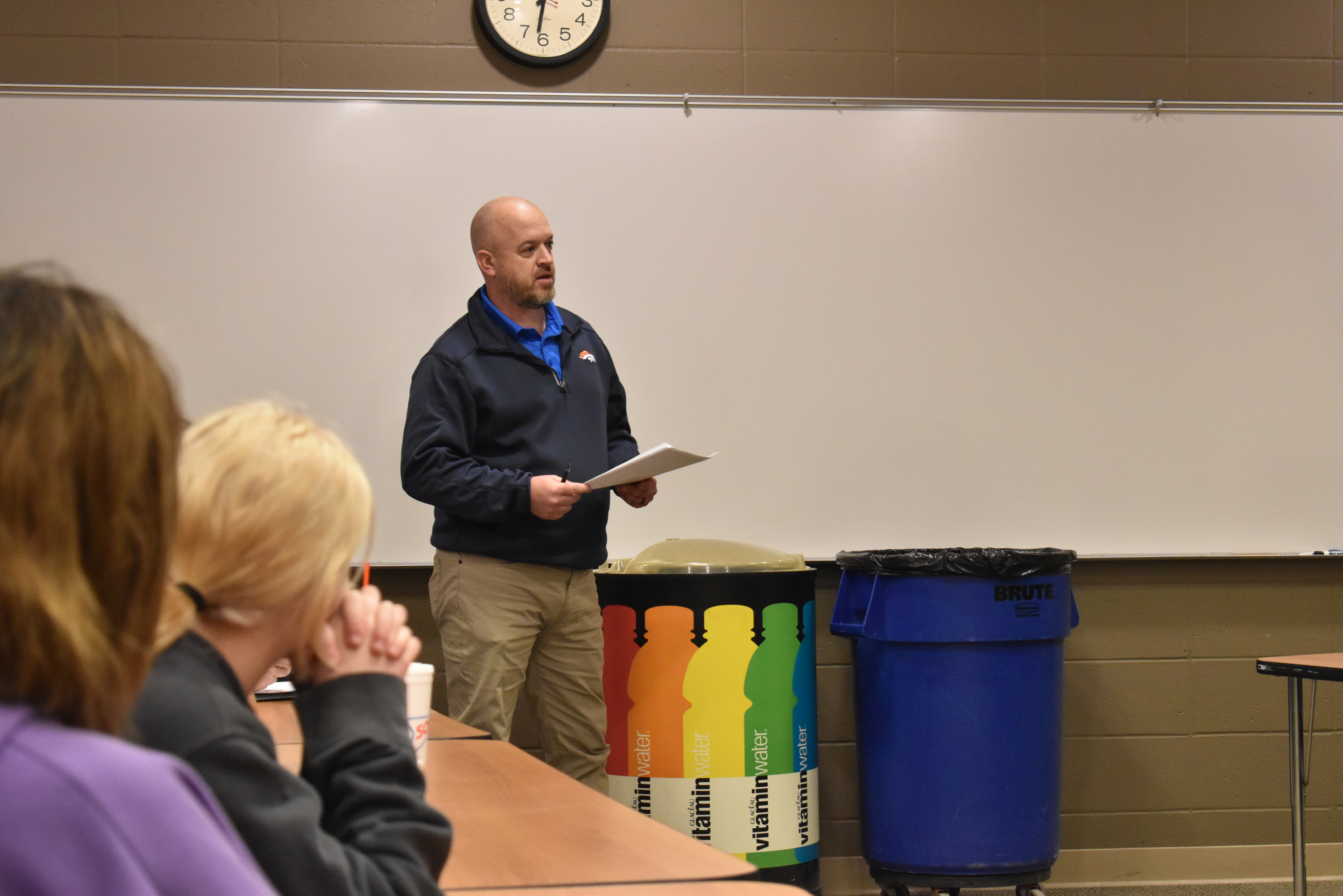 Democrat photo/Garrett Fuller — Zach Hackett, a proponent of adding a girls soccer program at California's middle and high school, persuades California R-I Board of Education members on adding the program at its March 15 meeting in the California High School media center. Hackett and other girls soccer proponents received more than $20,000 in pledges, with the most recent being a $3,000 donation from the California Fraternal Order of Eagles. In addition to funding the new program, he also talked about the increasing interest in girls soccer, and how many girls who wish to continue their soccer career are unable to do so once they age out of California's recreational leagues in the ninth grade. Board members unanimously approved the addition of a girls soccer program, with the condition that the program be completely self-funded for the first three years, the program starts with away games for the first two seasons and a head coach can be located for the team.
Democrat photo/Garrett Fuller — Zach Hackett, a proponent of adding a girls soccer program at California's middle and high school, persuades California R-I Board of Education members on adding the program at its March 15 meeting in the California High School media center. Hackett and other girls soccer proponents received more than $20,000 in pledges, with the most recent being a $3,000 donation from the California Fraternal Order of Eagles. In addition to funding the new program, he also talked about the increasing interest in girls soccer, and how many girls who wish to continue their soccer career are unable to do so once they age out of California's recreational leagues in the ninth grade. Board members unanimously approved the addition of a girls soccer program, with the condition that the program be completely self-funded for the first three years, the program starts with away games for the first two seasons and a head coach can be located for the team.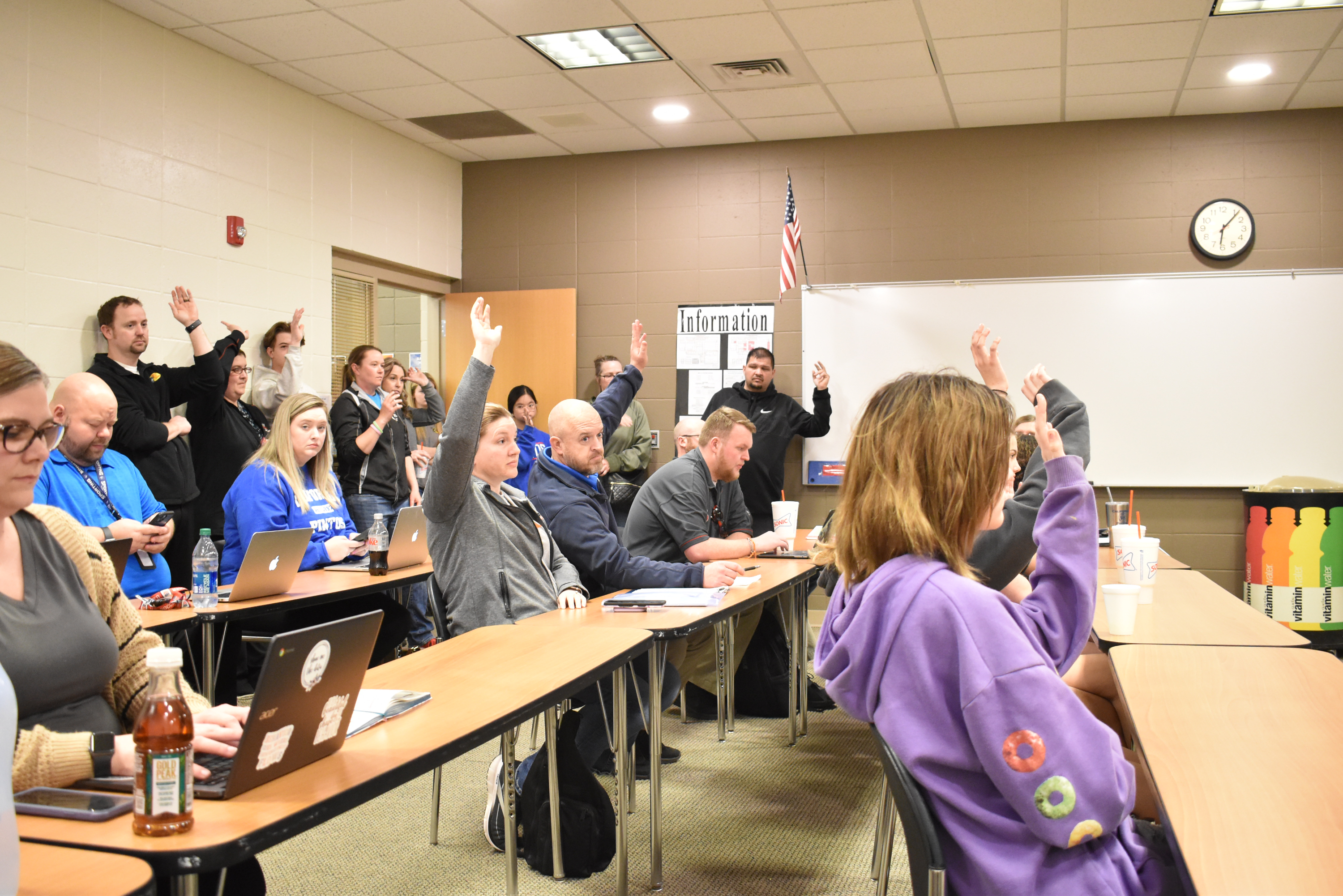 Democrat photo/Garrett Fuller — Members of the crowd supporting the addition of a girls soccer program at the March 15 California R-I Board of Education meeting hold their hands up to show support of the proposal in the California High School media center. The board approved the addition of a girls soccer program with the conditions that it be self-funded for at least the first three years, be a travel team for at least the first two seasons and a coach can be found for the new program.
Democrat photo/Garrett Fuller — Members of the crowd supporting the addition of a girls soccer program at the March 15 California R-I Board of Education meeting hold their hands up to show support of the proposal in the California High School media center. The board approved the addition of a girls soccer program with the conditions that it be self-funded for at least the first three years, be a travel team for at least the first two seasons and a coach can be found for the new program.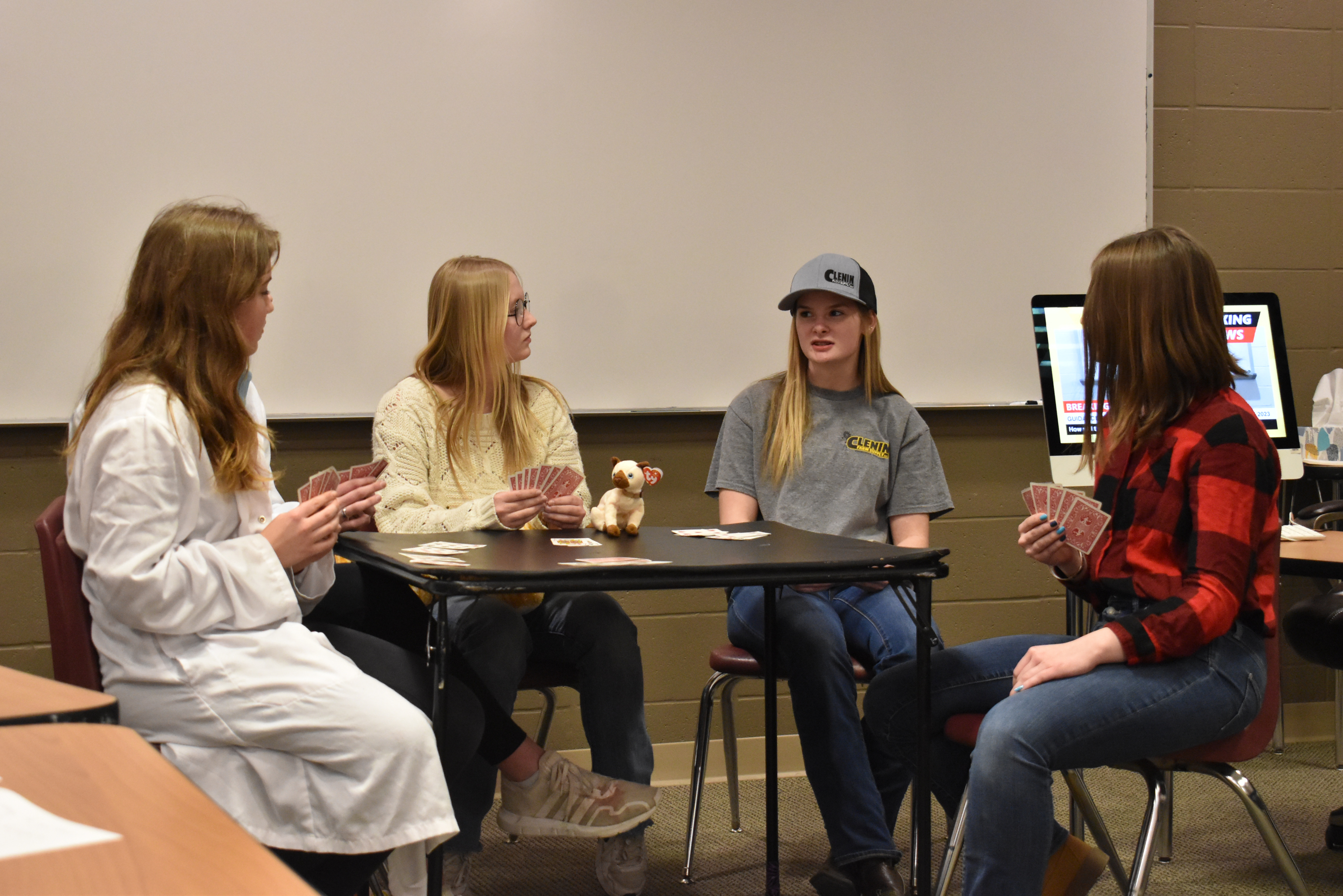 Democrat photo/Garrett Fuller — California High School agriculture students present a skit March 15 at the California R-I Board of Education meeting at the high school media center about a regulation requiring over-the-counter antibiotics for livestock to be prescribed by a veterinarian. Agriculture students will present other skits on agricultural issues at forums.
Democrat photo/Garrett Fuller — California High School agriculture students present a skit March 15 at the California R-I Board of Education meeting at the high school media center about a regulation requiring over-the-counter antibiotics for livestock to be prescribed by a veterinarian. Agriculture students will present other skits on agricultural issues at forums.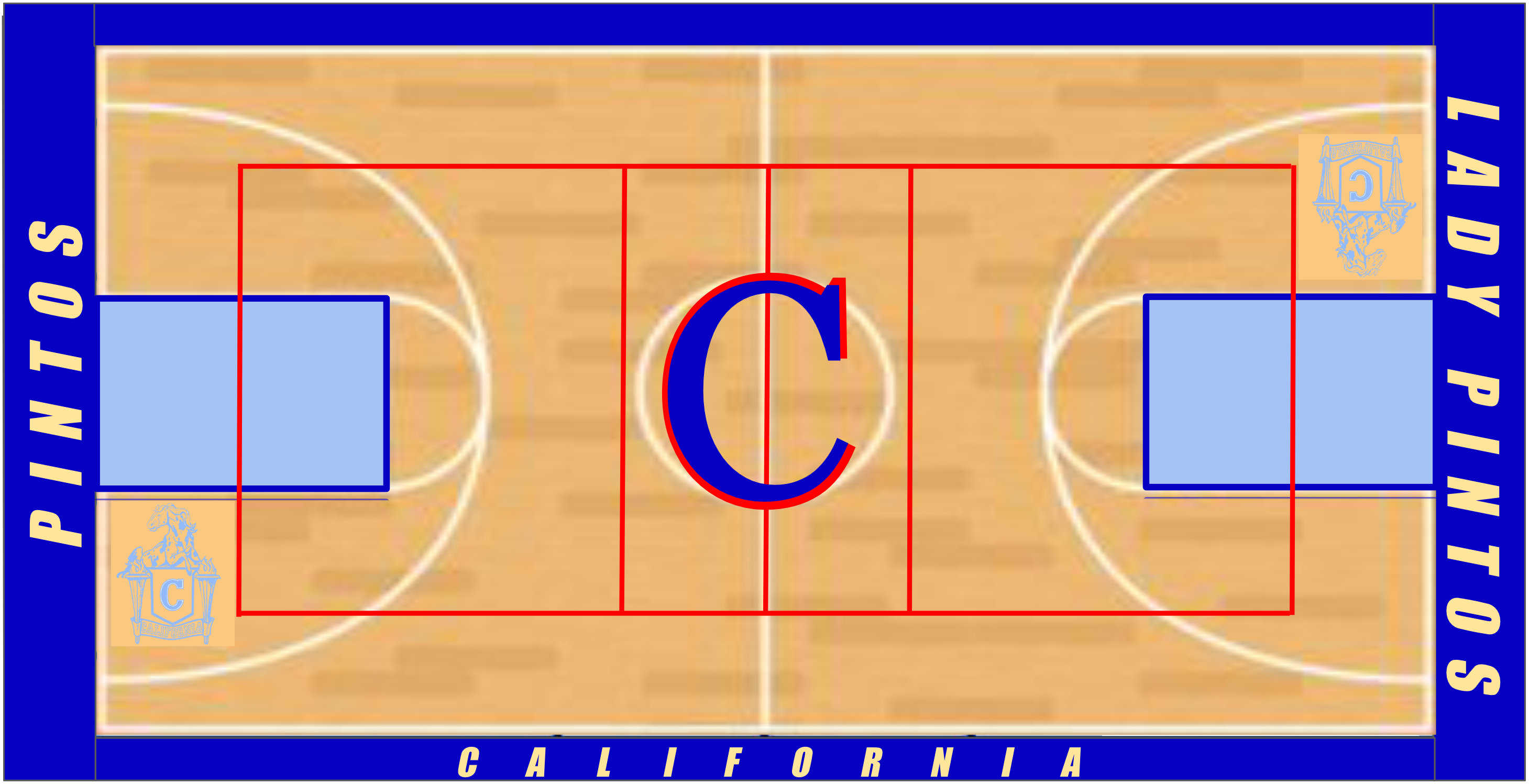 Submitted — The proposed redesign of the California High School gymnasium floor.
Submitted — The proposed redesign of the California High School gymnasium floor.
